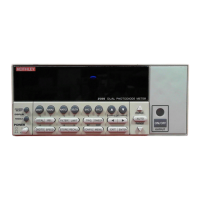13-12 Remote Operations Models 2500 and 2502 User’s Manual
<NDN> Non-decimal numeric — This parameter is used to send values in the
binary, octal, or hexadecimal format. The prefix designates the format
type:
#Bxx...x #B specifies the binary format.
xx...x is the binary number (using 0s and 1s).
#Qxx...x #Q specifies the octal format.
xx...x is the octal number (values 0 through 7).
#Hxx...x #H specifies the hexadecimal format.
xx...x is the hexadecimal number (values 0
through 9 and A through F).
Examples to send the decimal value 36 in the non-decimal formats:
*ESE #b100100 Binary format
*ESE #q44 Octal format
*ESE #h24 Hexadecimal format
Angle brackets < >
— Angle brackets (< >) are used to denote a parameter type. Do not
include the brackets in the program message. For example:
:OUTPut2 <b>
The <b> indicates a Boolean-type parameter is required. Therefore, to
enable the selected source, you must send the command with the ON or
1 parameter as follows:
:OUTPut2 ON
:OUTPut2 1
Query commands
This type of command requests (queries) the presently programmed status. It is identified
by the question mark (?) at the end of the fundamental form of the command. Most com-
mands have a query form:
:ARM:TIMer? Queries the timer interval.
Most commands that require a numeric parameter (<n>) can also use the DEFault, MINi-
mum, and MAXimum parameters for the query form. These query forms are used to deter-
mine the *RST default value and the upper and lower limits for the fundamental
command. Examples are:
:ARM:TIMer? DEFault Queries the *RST default value.
:ARM:TIMer? MINimum Queries the lowest allowable value.
:ARM:TIMer? MAXimum Queries the largest allowable value.
Test Equipment Depot - 800.517.8431 - 99 Washington Street Melrose, MA 02176
TestEquipmentDepot.com

